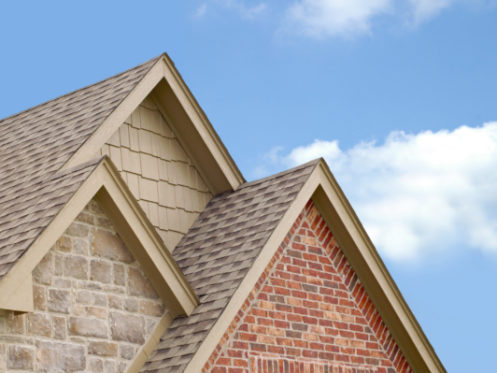Although steeply sloped roofs are aesthetically pleasing, their designs are often more about function than form. Whether you own a brand-new home in Woodbine, New Jersey or you’ve got an older property that’s ready to be reroofed, it’s important to understand what roof pitch is and how it impacts things like longevity, integrity, and performance.
Although steeply sloped roofs are aesthetically pleasing, their designs are often more about function than form. Whether you own a brand-new home in Woodbine, New Jersey or you’ve got an older property that’s ready to be reroofed, it’s important to understand what roof pitch is and how it impacts things like longevity, integrity, and performance.
What Is a Roof’s Pitch?
Roofs with two or more sides meet at a peak. The slope or angle of the roof is commonly referred to as a roof pitch. When designing a roof, roofers use a special measuring system to determine how steep this pitch should be. Things like snow loads and average precipitation make it necessary for roofs to have a minimum slope or slant. This way, heavy accumulations will naturally slide off rather than subjecting the roofing to snow or ice weight.
Roof pitch is usually indicated as a ratio. This ratio shows how much the roof rises in inches for every horizontal foot that it travels toward the roof peak. For example, a roof that has a 5:12 pitch rises 5 inches for every 12 inches of horizontal space that it travels toward the roof’s highest point. In the interests of preventing sagging, moisture damage, and the collection of stagnant water, even “flat” roofs have a slight pitch.
Why Roof Pitch Matters
While the most obvious benefit of a significant roof pitch is the ability to shed excess snow and other precipitation, a sufficient pitch can prevent other forms of roofing damage. When calculating roof pitch, roofers get an idea of what materials will and will not work well in the intended application. Thus, roof pitch determines how limited or expansive your options are when choosing a roof style, and it also makes it easier to select products that will hold up over time. Although pitch is just one of multiple factors that determine the overall performance of roofs, it easily ranks among the most important.
Roof pitch can also play a hand in determining your roof’s:
- Ease of maintenance
- Lifespan
- Walkability
- Compatibility in snowy climates
Before you decide whether you want an all-copper roof, an asphalt shingle roof, or a tile roof, your roofer must calculate the ideal roof pitch.
Factors That Determine the Ideal Roof Pitch
When designing and building new homes and when remodeling or renovating existing construction, there are several key factors that determine a structure’s ideal roof pitch. These include:
- Budget
- Preferred roofing materials
- Local climate
- Intended rooftop installations
- Ongoing maintenance concerns
- Attic sizes
- Attic ventilation and insulation
- Preferred aesthetics
If you want your house to have a steeply gabled, fairy tale or cottage-like appearance, what you really want is a substantial roof pitch. For steeper slopes, heavier materials rarely work. The risk of having weighty shingles or tiles slide off of a steeply sloped roof is a major concern. Thus, you can have a steep slope, but you cannot pair it with certain roofing products.
Flat roofs are never truly flat given that all roofing systems have a pitch of at least one inch per foot. Flat roofs are also never a good choice in places where heavy winter snows are the norm because of snow load. If you like the look of a flat roof but live in an area where build-ups of precipitation are common, you can work with a roofer to determine the lowest pitch possible for your roof, and you can then establish your design accordingly.
If you intend to use your attic as a bedroom or a storage area, a higher pitch will give you more interior space. However, choosing a higher roof pitch may create the need for better ventilation and greater amounts of attic insulation. Professional roofers can tell you which factors affect your design visions, and which pitch will provide the greatest amount of longevity and value overall.
Why Do Budget and Maintenance Matter?
Steeply pitched roofs like those seen on historic cottages require more labor to install. Due to their excessive slopes, putting these roofs on and caring for them entails more physical risk as well. Thus, you’ll invariably pay more for an excessively steep roof than you would for one that has a more moderate and needs-specific pitch.
Steeply sloped roofs aren’t very walkable either. This matters to both you and any roofing professional that will be maintaining your roof over time. Whenever roofing issues arise, your roofers will likely need special fall prevention equipment to resolve them. As such, if you’re eager to have a steeply pitched roof installed purely for aesthetic purposes, it’s important to carefully consider the long-term costs of doing so.
Calculating a Roof’s Pitch
To calculate the pitch of an existing roof, start by measuring its run. This is the horizontal distance that it travels from the edge of the roof to the highest point of the roof peak. If the roof peak is directly over the center of an exterior wall, the roof’s run will be half of the wall’s horizontal measurement. For instance, for a 10-foot wall with a pitched roof that peaks at its center, the run of the roof would be 5 feet.
The next step is to determine the roof’s rise. This is the height of the roof’s peak above the wall. Thus, you’d measure from the top of the wall or the start of the roof to the very tip of the roof’s peak. By dividing the roof’s rise by its run, you’ll get the tangent. Divide the number one by your roof’s tangent and then multiply your answer by 180 divided by pi, or 3.14. If you aren’t mathematically inclined, let a licensed roofer do the calculation for you. This equation will give you your roof’s pitch in degrees or the angle of your roof.
More commonly, roofers calculate and express pitch as a ratio by simply comparing a roof’s rise to its run. To express your roof’s pitch as a ratio, measure how much your roof rises vertically (X) for every 12 inches that it travels vertically (12). This ratio is expressed like this: X:12.
High-Pitch and Low-Pitch Roofs
Roofs are usually broken into two categories: high-pitch and low-pitch. Low-pitched roofs are only found in relatively arid areas or regions that have consistently low levels of annual precipitation. Roof pitches that range between 1:12 and 3:12 are considered low-pitched. 1:12 is the lowest roof pitch possible, and roofs that have it are known as flat roofs.
Roofs with pitches ranging between 4:12 and 7:12 are moderately pitched roofs. Roofs with pitches of 8:12 or higher are high-pitched roofs. Due to their weight, roofs with pitches greater than 12:12 cannot be built with heavy materials such as asphalt shingles, wood, or tiles.
At Jim Rhubart Roofing, we work hard to help our clients make informed decisions about their roofs. We’ve been proudly serving residents of Woodbine, New Jersey and the surrounding area since 1975. We offer roof repair, replacement, and maintenance services. If you need help determining your roof’s pitch or if you have other roofing concerns, give us a call today!
End Of Article






